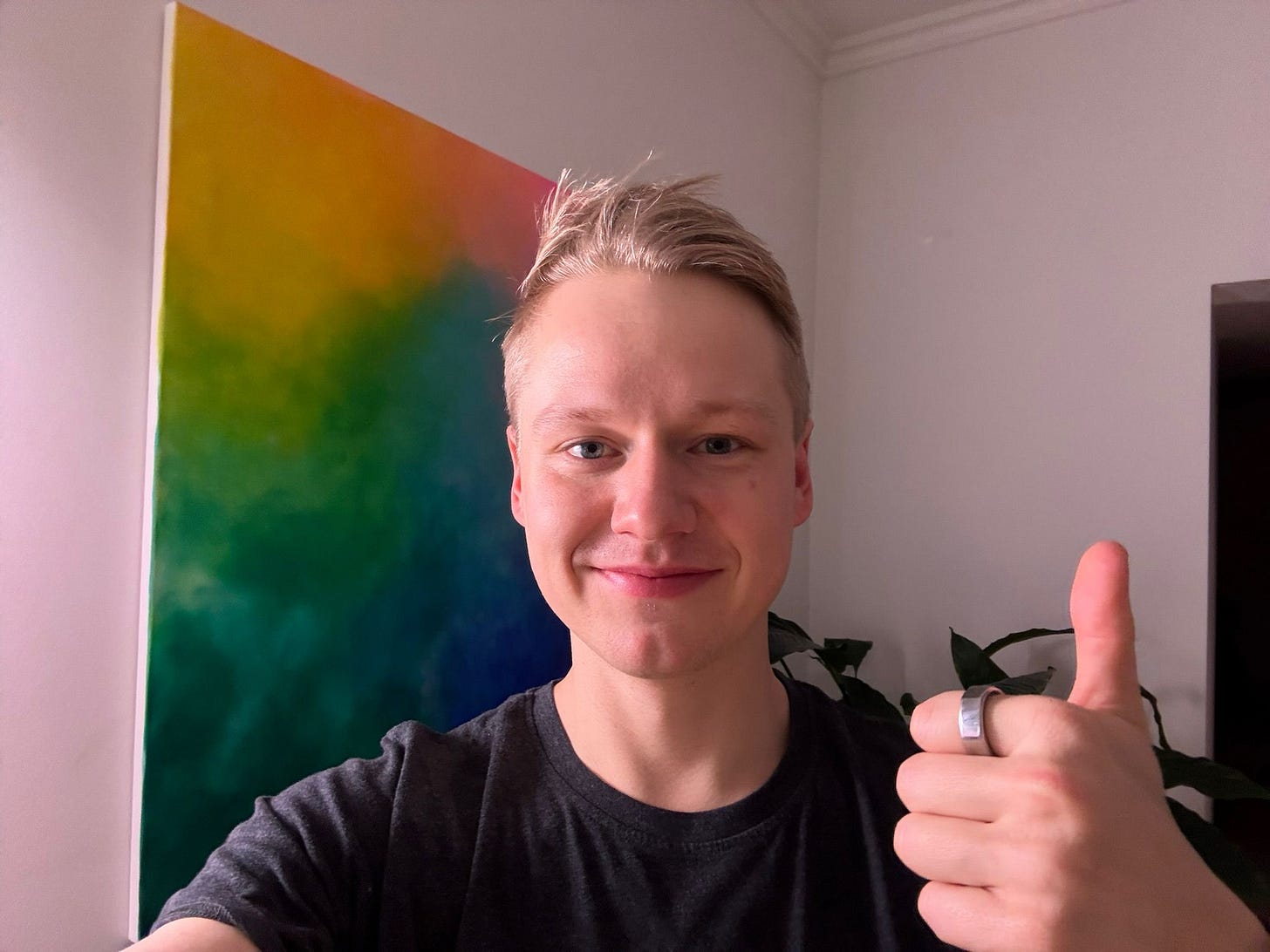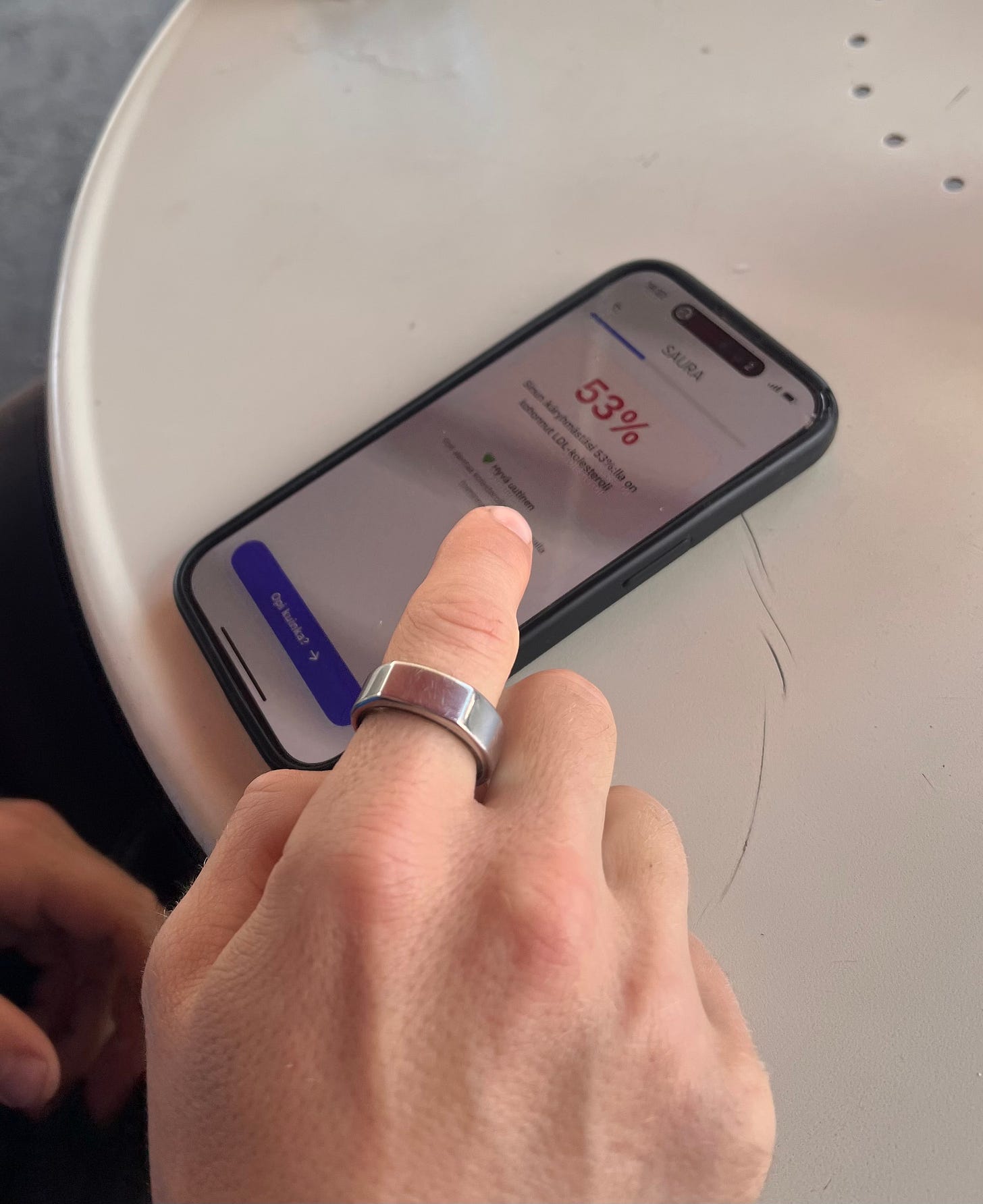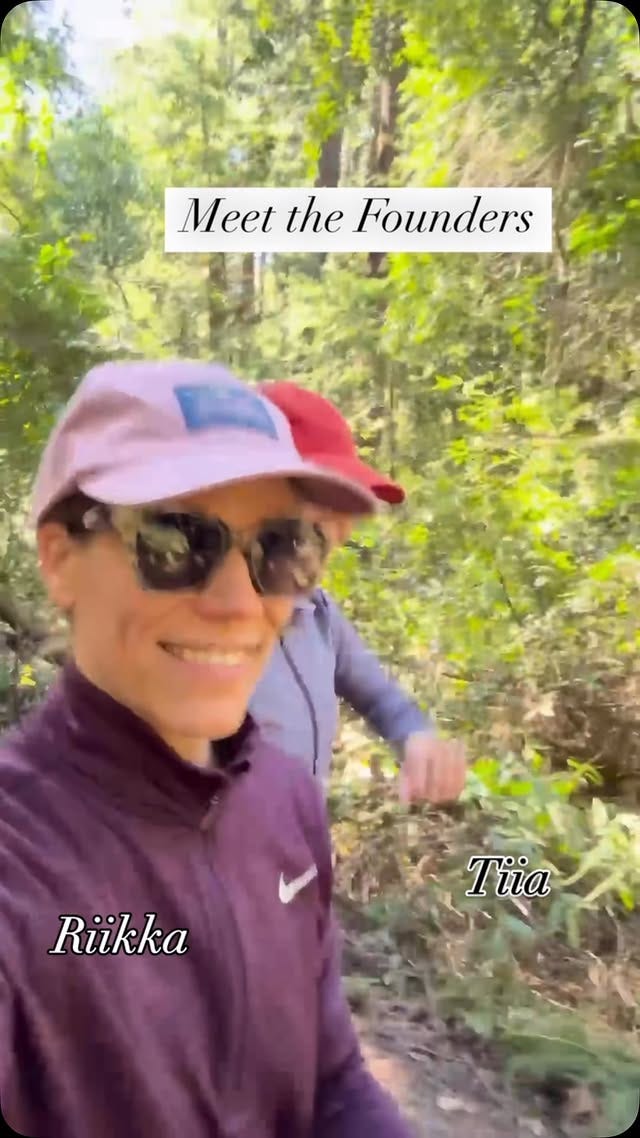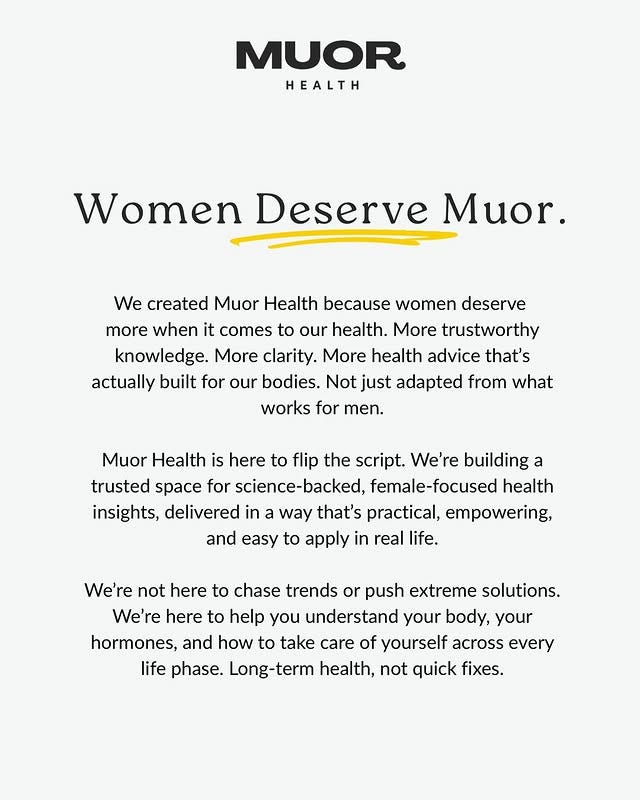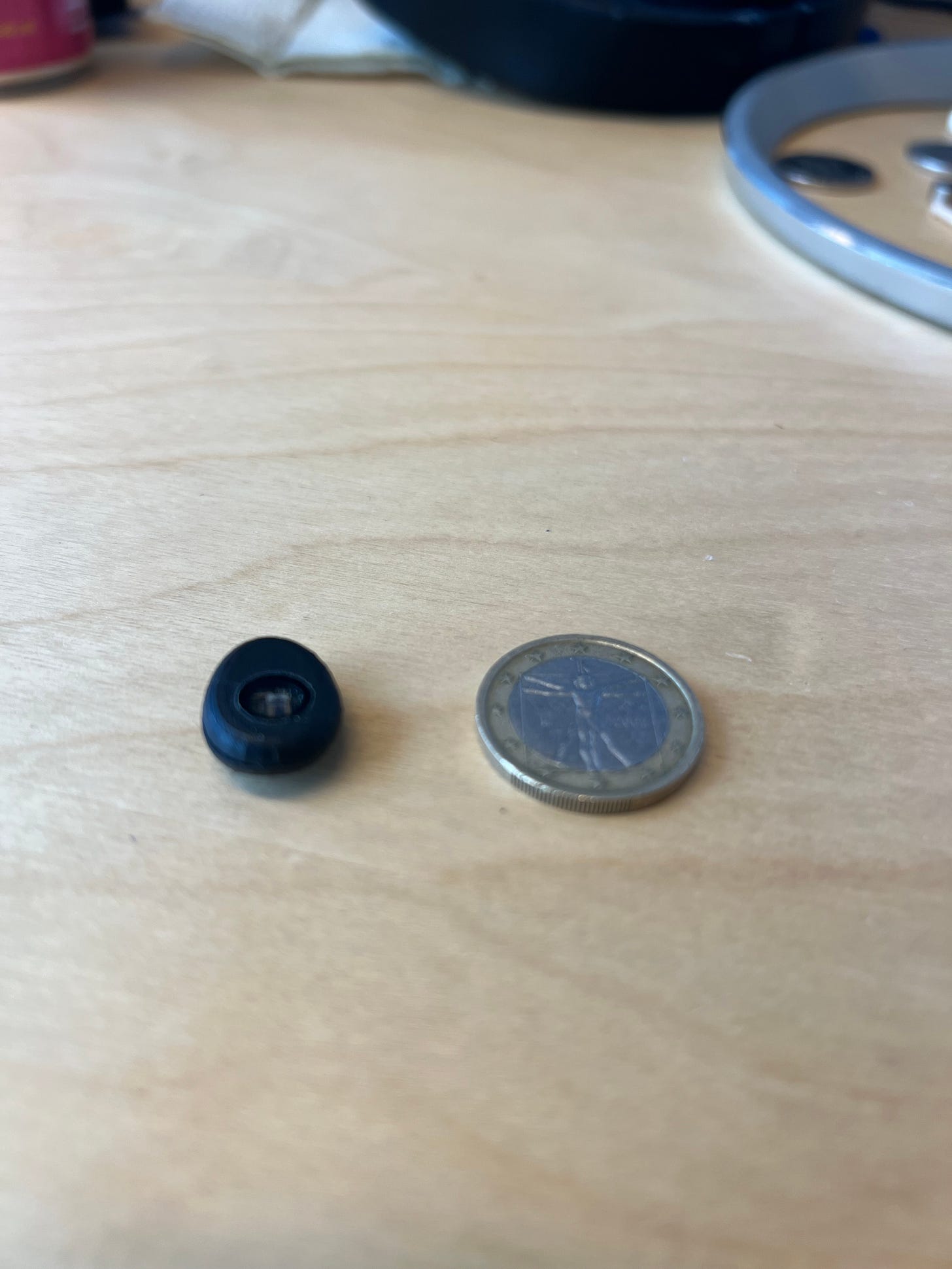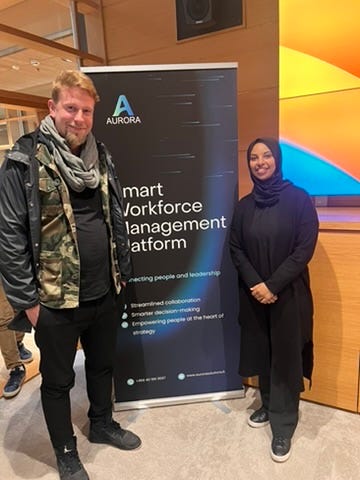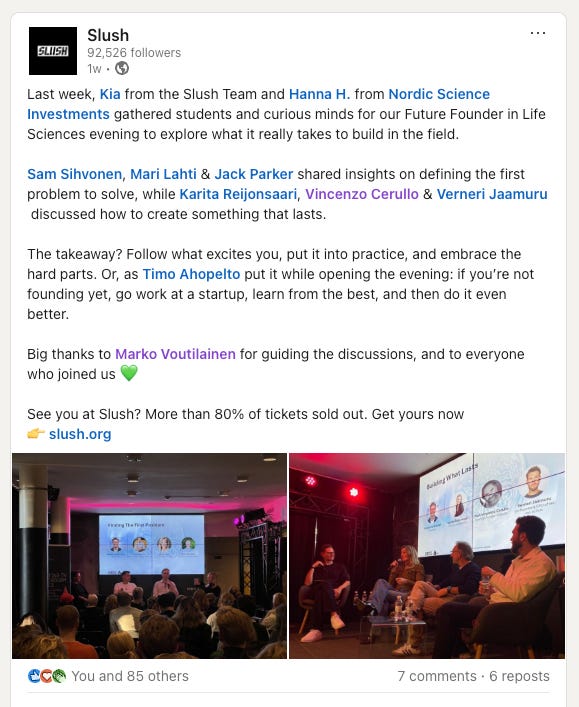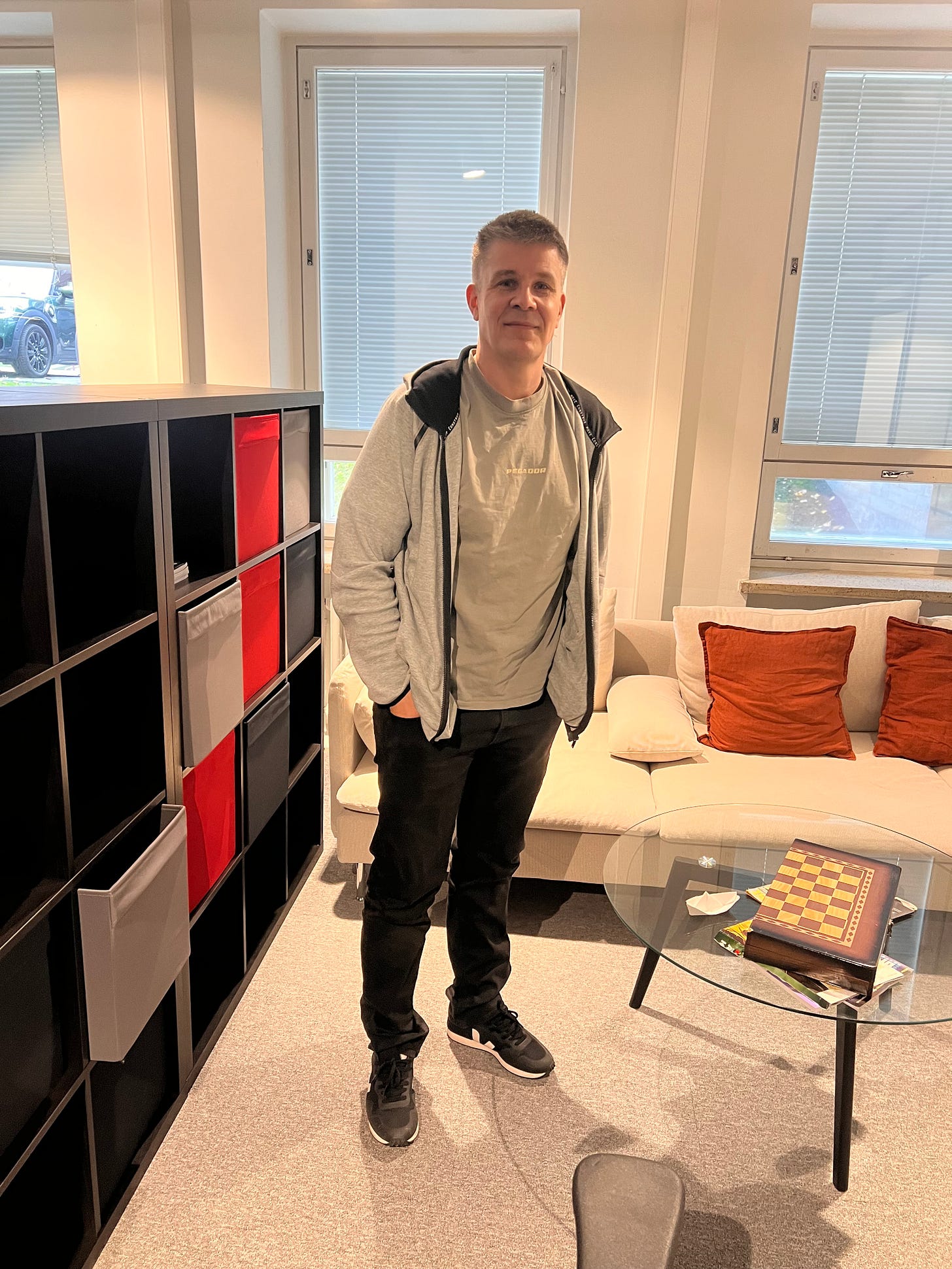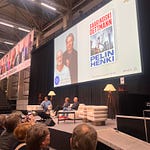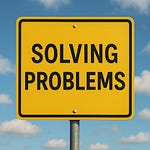Welcome, reader! The first rule of Just Thoughts is, “Why should I think that way?”
To read this whole edition of Just Thoughts, you’ll need to download the Substack app
This edition of Just Thoughts is a long one. Sparked by the word on the street that the startup ministers (featured many times on Just Thoughts) are sharing stories on their podcast that are a few decades old when it comes to their own experiences, and me wanting to help, I wondered what it’s actually like to be a health tech entrepreneur in today’s world.
We can, of course, talk about local and global differences, but my immediate network consists of individuals deeply involved in what you might call a “passion sport.” Hence, this edition of Just Thoughts features five entrepreneurs with roots in Finland who are building health tech at various levels.
The consumer health tech giant Oura is too busy being a decacorn, swallowing the best of the best, by acquiring Veri and one of the most promising CEOs from the local startup scene, Anttoni Aniebonam. Nonetheless, the question is who’s left out there, and what’s it like being a grassroots player?
This article consists of interviews turned into reviewed (by the interviewee) blog inserts, created with the help of Claude. The ingress is handwritten, and the TL;DR is a summarized collection of all the learnings. We’ll conclude with some handwritten reflections on what to expect from a Just Products deep dive into the health tech space.
The NotebookLM-generated podcast snippets have been incredibly popular Just Thoughts inserts, and when I listen to the “debate” in the attachment here, my reaction was “damn, that’s good”.
I chose the debate, but if you're looking for an engaging, in-depth discussion of all the content, I've uploaded one here.
Headlines this week
TL: DR - What’s it like being a Health Tech entrepreneur from Finland
Introducing the builders
Building with Saura: Making Health Data Actionable for Everyone
Building Muor Health: Why Women’s Health Knowledge Matters
Building Medical Devices: Why Healthcare Hardware Is Different
Reflections & Special Mentions
What’s next?
What’s It Like Being a Health Tech Entrepreneur from Finland?
The brutal truth: It’s a passion sport, not a typical startup play. Years to market, not months. Massive upfront investment before revenue. You can’t generate revenue the same way you do in consumer plays. If you don’t have the endurance, don’t start; there are easier plays out there.
The funding paradox: Finnish instruments, such as “Tempo”, “Into”, and “Innovointi seteli”, have disappeared, and there are none dedicated to medical hardware. EU grants require you to be already past the early stages.
Early-stage MedTech HW doesn’t fit the traditional VC math due to long time-to-money and regulatory risks. However, exits often occur early (under €100M) as big corporates buy them out to avoid competition, or because that’s generally how big pharma innovates. Hence, medtech players are rarely seen as “fund returners”, despite high exit probabilities (compared to other domains), but in their defense, unicorn exits do happen.
Additionally, many successful medtech companies are university spin-offs that secure R&D funding before launch; however, these spin-offs often lack the business acumen necessary for scaling successfully.
The regulatory maze: Everything requires documentation explaining every decision. FDA 510(k) pathways are clearer than the EU’s fragmented landscape, but you still can’t dump patient data into ChatGPT, meaning you need to set up your own inference clouds.
Medical devices need proven accuracy thresholds; consumer wellness apps don’t. The timeline difference is stark: one founder spent 8 years reaching approval while managing product iterations that each required complete documentation.
The mission trade-off: Multiple founders chose to self-fund or bootstrap specifically to avoid investor pressures that force them to pivot away from their original health missions toward mass-market plays.
One founder explicitly rejected accelerators to maintain control over their mission while balancing the needs of young children and financial stability. Another built a 30-day intensive health program (not a lifetime-value app), knowing it wouldn’t fit VC math.
The advantage of starting in Finland: If you already have US network connections (such as from selling a previous company there), you can build technical teams in Helsinki at a lower cost while accessing US market relationships.
Without those connections, you’re essentially starting from zero in an impossibly complex system. Hence, you find the connections or willingly deal with the impossible.
The bright spots: Finding mission-driven talent is easier, 75-80% of health tech candidates have personal connections to the diseases being addressed. AI tools (especially Claude Code) dramatically accelerate technical work. The knowledge gap in women’s health and treatment adherence creates a genuine opportunity for science-backed education and intervention.
Bottom line: Expect 99% failure risk, more prolonged suffering, limited exit upside, and constant choice between mission purity and investor expectations. However, if you prioritize a measurable health impact over high probability for unicorn valuations and have either existing US healthcare networks or a willingness to build over the course of a decade, it’s winnable. Health tech is not for the faint of heart; it’s a passion sport.
Building Saura: Making Health Data Actionable for Everyone
Who I am
I’m Tatu, founder of Saura, a health tech app focused on cholesterol management. I’ve been part of the Finnish startup scene for over a decade, since my high school days when a friend dragged me from Myyrmäki to the Aalto Entrepreneurship Society’s open meetings in Otaniemi.
I never left that path. Before Saura, I worked on growth at Swappie, helping millions buy and sell used iPhones. But I kept asking myself: why be an entrepreneur? For me, it’s about maximizing positive impact. Politics could work, but startups offer faster, larger-scale change without the same ceiling constraints.
What I’m solving for
High cholesterol affects millions, but most people are unaware of how their daily food choices contribute to their condition. Saura makes it tangible: you photograph your meals, and the app tracks whether you’re hitting targets for fiber, saturated fats, and polyunsaturated fats based on Finnish nutrition guidelines. After 30 days of staying on track, we will re-measure your cholesterol, long-term blood sugar, and inflammatory markers.
Real results, I personally dropped my cholesterol 30 points in a month, and many users are shocked to discover they’re eating 30-50% more saturated fat than they thought, even when trying to eat healthy.
The key difference is that we use a new at-home blood testing device (no needles) that isn’t yet widely used in Finland. Rather than offering 200 lab values with unclear action steps, we focus on the specific markers you can actually improve through behavior change, with concrete evidence of impact.
What is challenging in health tech
The regulatory landscape is complex. We operate as a medical device reseller, integrating with healthcare information systems and navigating data security requirements that differ from those in consumer technology. I’m doing everything myself, including coding, regulatory navigation, and all operational work. I have a doctor, a nutritional therapist, and a cloud developer supporting me part-time, but I’m the only one full-time.
There’s also a philosophical challenge: investors typically want to maximize lifetime value, but Saura is intentionally a 30-day intensive program, not an endless daily task app. I’ve explicitly self-funded to avoid compromising this mission. The goal isn’t just app engagement metrics; it’s actual health improvement, as evidenced by your blood work, which motivates longer-term behavior change even after you stop using the app.
And there’s the diagnostic paradox: as AI improves and testing becomes cheaper, we’ll find more abnormalities. But if our healthcare system can’t make rational decisions about what actually needs follow-up versus what’s benign, we risk creating over-treatment complications. We need AI sophistication in interpretation to match the increased testing capacity.
What I need
I’m actively using Claude Code as my primary AI tool; it runs in my terminal with more system access than typical AI services, handling everything from prioritizing my to-do list to code reviews. I’m excited to apply similar AI workflows to marketing once I shift from this coding phase.
If you’re comfortable on camera and want to test Saura, document your process and create content around it, reach out for a complimentary package. I need people who can authentically share their experience. And if you’re interested in selling farmland, I’m also interested in that (a separate passion for agriculture 💚). More broadly, I’d value connections with others navigating the balance between building impactful health interventions and staying independent of investor pressures that might dilute the mission.
The three trends I’m watching:
1) People taking more responsibility for their health
2) Diagnostic testing is becoming more accessible, and
3) AI is improving interpretation.
When these converge properly, we can shift from population-level health economics to truly personalized health management.
👉🏻 Reach out: tatu@saura.health
Building Muor Health: Why Women’s Health Knowledge Matters
Who I am
I’m Riikka, co-founder of Muor Health, and my journey into women’s health tech started from deeply personal places. Nine years ago, my mother received an early-onset Alzheimer’s diagnosis, which later turned out to be PSP, which is a rare neurodegenerative disease. That turning point made me confront my own health future. Then, when my daughter was born two and a half years ago, I experienced firsthand how little support exists for women navigating pregnancy recovery. These moments pushed me to shift my focus from superficial health goals to longevity and a deeper understanding of how women’s bodies work.
What I’m solving for
Here’s what shocked me: between 1977 and 1993 in the US, women weren’t included in clinical trials at all, and even before that time period, women were rarely included in research studies. This means many medication dosages are based on male physiology, which is why women experience 1.5 times as many adverse drug reactions.
The research gap is massive; for example, erectile dysfunction, affecting 19% of men over their lifetime, has been studied five times more than premenstrual syndrome, which affects 90% of women. Women wait an average of 2.5 years longer to get a cancer diagnosis. With some women-specific conditions like endometriosis, it can be as long as 10 years to get a diagnosis. Conditions like ADHD manifest differently in women, and women get their diagnosis 4 years later on average.
We’re building Muor Health to provide women with foundational knowledge about their bodies, including how hormones affect sleep, what health trends are science-backed and based on studies on women, and why health advice designed for men may not work for them. At this point, we are not focused on creating another product, but rather on establishing a trusted source of science-backed health information through a female lens that empowers women to take control of their health and advocate for themselves.
What is challenging in health tech
I struggled with imposter syndrome while working in Silicon Valley, where everyone is “shipping product”, building technology, and raising money. We are bootstrapping, having started with a course and then switched to a newsletter; it felt almost too simple. But the content problem is exactly what needs fixing, and we believe that once you’ve built an audience that trusts you, successfully shipping products is much easier. With AI rapidly multiplying health information, women need help understanding what’s actually relevant and science-backed.
Additionally, I’m a founder with a young child and an entrepreneurial husband. I wanted to choose a path that’s financially stable and where I can control my time, which means not pursuing accelerators or fundraising at this time. I’ve watched health companies here pivot completely away from their original mission to satisfy investor growth expectations. I’m not willing to compromise our mission at this stage, even if that means slower growth.
What I need
Right now, we need to build community carefully. We’re launching our first survey to validate our target audience. Still, we’re taking our time with moderation and real-time engagement, and we want to maintain our reputation as a trusted and accurate source.
What would help most? Connecting with others who are solving related problems, especially those working on women’s health data gaps or building tools that complement educational content. And connecting with other founders who have chosen the bootstrapping route, who are building amazing products without following the traditional VC playbook. People who get that mission can come before massive scale, at least for now.
If you’re working in women’s health or know someone who should be part of this conversation, reach out. This space needs more voices committed to the long game.
👉🏻 Reach out: hello@muorhealth.com
Building Medical Devices: Why Healthcare Hardware Is Different
The funding landscape is fierce. Early-stage MedTech HW doesn’t fit the traditional VC math due to long time-to-money and regulatory risks. Exit frequencies are high, but valuations are often under €100M, not fund returners. Large medical companies frequently purchase promising devices early, sometimes to prevent them from falling into the hands of competitors. Meanwhile, you need substantial capital to reach approval, creating a chicken-and-egg problem. Many successful medical device companies are university spin-outs with R&D funding already secured.
Who I am
I’m Peik, and I’m developing a medical device for sleep apnea diagnosis, specifically, an ear-mounted sensor that monitors multiple parameters overnight. I’ve been involved in this field for about five years now, having worked on our fifth major version of the device. Previously, I worked on other tech product startups, which provided a solid foundation; however, medical hardware is an entirely different challenge. More than anything, it’s a passion sport.
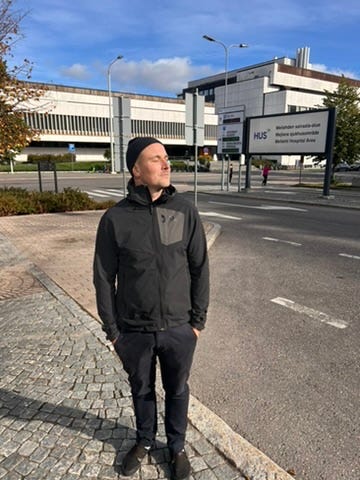
What I’m solving for
Sleep apnea affects millions, but diagnosing it is often complicated and costly. Current at-home devices frequently rely on Multiple sensors or single-sensor devices with limitations in monitored parameters.
We are developing a single, ear-mounted device that collects all necessary diagnostic information from a single measurement point. The ear is ideal because it faces minimal interference from muscle movement, is less likely to be accidentally removed during sleep, and is unobtrusive.
Our initial focus is on the US market due to the significant market opportunity, and the FDA 510 (k) regulatory process is more straightforward when there are predicate devices to reference.
What is challenging in health tech
Medical hardware is truly a passion project, not a typical startup venture. You’re facing years, not months, to reach the market. The 510(k) regulatory approval process alone requires considerable time, and you can’t generate actual sales until approval is obtained.
Each design iteration must be thoroughly documented, along with the specific reasons for your choices. From the outset, you must strike a balance between technical feasibility and regulatory compliance.
The funding landscape is particularly tough. Early-stage MedTech HW doesn’t fit the traditional VC math due to long time-to-money and regulatory risks. Exit rates are high, but valuations are often under €100 million, which is insufficient for a fund returner. Large medical companies frequently purchase promising devices early, sometimes to prevent them from falling into the hands of competitors.
Meanwhile, obtaining approval requires a significant amount of capital, creating a chicken-and-egg problem. Many successful medical device companies are university spin-offs that have already secured R&D funding.
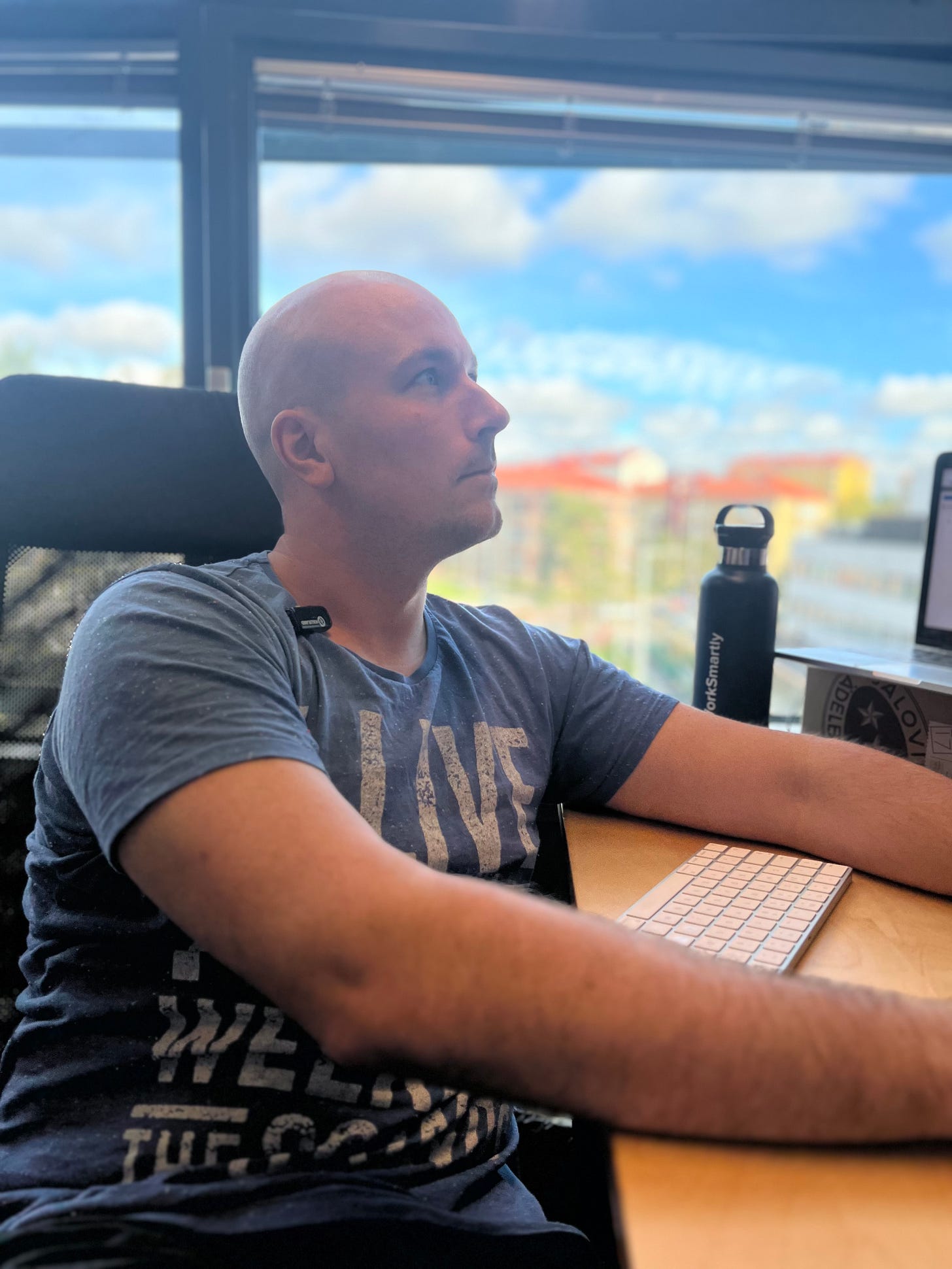
In Finland, key funding tools like “Tempo”, “Into”, and “Innovointi seteli” have been discontinued. EU grants still exist, but require you to be beyond the initial early stages.
What I need
The medical device ecosystem benefits from investors who recognize that different success metrics apply here compared to those in the consumer technology sector. This sector requires investors who are comfortable operating in regulated environments, where steady, high-probability exits can yield strong expected returns, even without aiming for unicorn valuations. You don’t need billion-euro valuations when consistent €50–100 million exits can outperform in terms of expected value.
It’s also important to note that consumer wearables and medical-grade devices operate in entirely different spheres, as they vary in terms of accuracy standards, validation procedures, regulatory processes, and go-to-market strategies, targeting clinics and healthcare systems versus direct-to-consumer channels.
In our situation, we already work closely with key stakeholders, including clinical partners and approval authorities, and these relationships continue to strengthen our foundation.
Still, more connections are always beneficial. If you’re involved in sleep medicine, wearable diagnostics, or familiar with U.S. clinical networks, insurance reimbursement models, or the FDA 510(k) pathway, I’d love to exchange perspectives.
👉🏻 Reach out: Peik@corle.fi
Reflections & Special Mentions
Everyone will say regulations are good for society at large, especially to maintain good relations with regulatory authorities. However, the truth is that everything can “be interpreted” in different ways, and the regulatory environment varies significantly across the globe, causing stark differences in business model applicability for health tech endeavors.
In Finland, where the economy is small, it feels like you’re fighting against windmills when trying to get an endeavor off the ground. If you try to get any money invested, investors start pushing you in seven different directions to find profitability. For every investor who has invested in health tech even once, don’t expect them to do it again.
However, I’d argue every fund should have at least one health tech founder in its portfolio for two reasons:
1) Your health tech founder will be more resilient, have more character, be bolder, and be more mission-driven than any other founder in your portfolio. That will rub off on everyone else if you’ve built your platform right. Are they different from the founders of impact tech companies? Not necessarily, but the health tech founders I’ve met tend to be serial entrepreneurs, rather than those who aspire to be “one company for a lifetime.” This has value across your stakeholder network.
2) We can’t leave health tech to foundations, universities, governments, and dedicated funds. To keep health close to humanity, health entrepreneurship needs to feel accessible and achievable. Having one health tech Maverick supported at any given time creates social compound effects that not only help everyone succeed but may turn out highly lucrative.
Finally, creating this insert proved to be very challenging because the amount of domain-specific knowledge required to engage in a productive discussion or ask the right questions is substantial.
There were also several related discussions and startups in the space that didn’t make this insert. One of them was Hoiwa, which staffs hospitals and released its general workforce management tool, called Aurora.
Their tool got listed by Emerge Insights Health AI in their Health AI Market Cap review (Hoiwa under “workforce management”). Aurora, however, doesn’t only aim to capture staffing admin needs in health tech, but across the entire gig working economy.
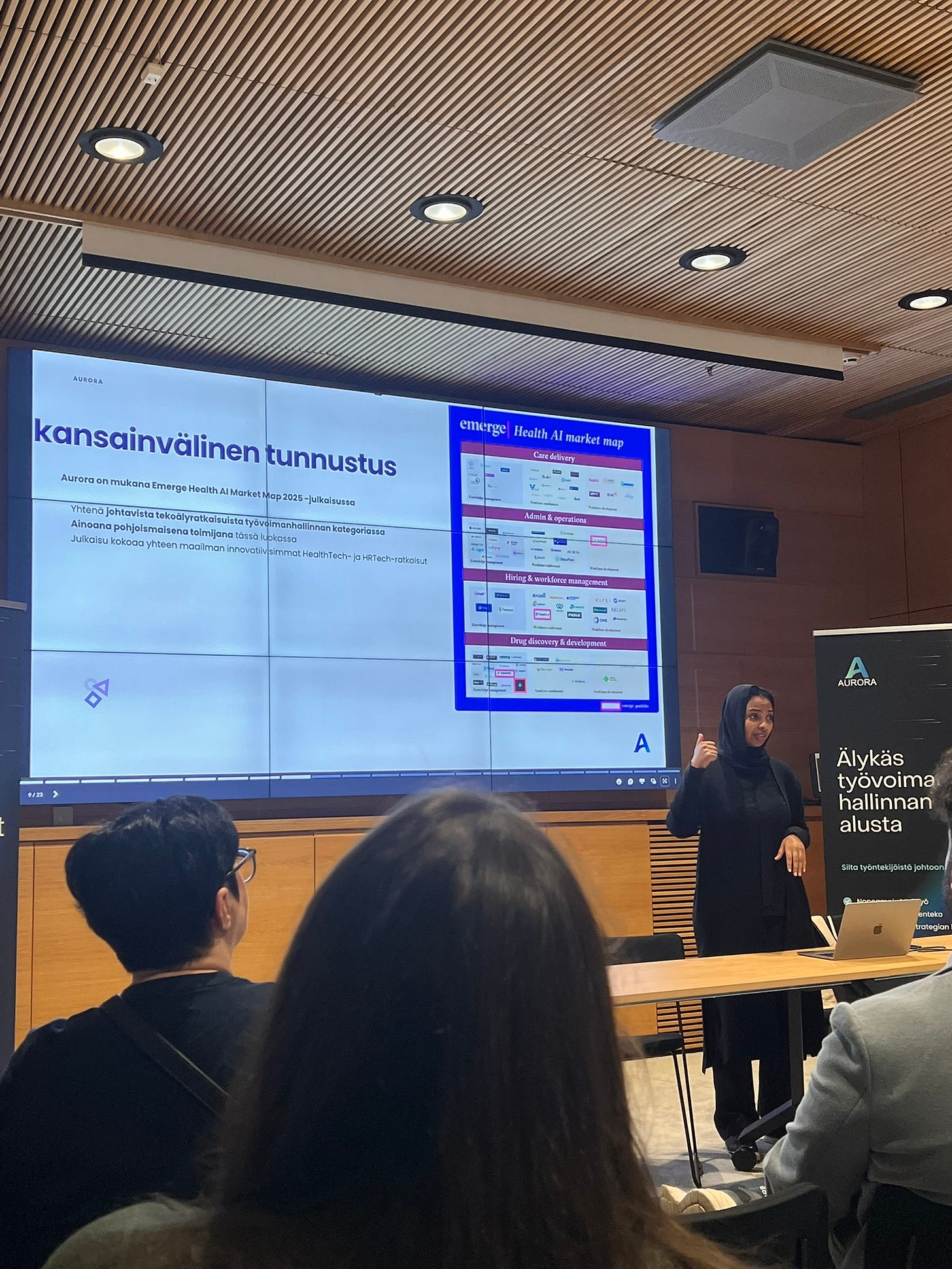
Slush also recently hosted a life sciences event at the local hub, which is worth mentioning, featuring some notable names in the local scene. Although the advice from Timo, one of the startup ministers, was generic regarding entrepreneurship and not specific to what it takes to be a health tech or, more broadly, a life science founder.
Other notable mentions include Vaalia.Health, and they’re using causal AI, not the hyped deep learning models, but academic techniques that answer “why” questions and enable intervention planning.
Their Co-founder, Jani Ahonala (who founded and sold Noona), brings crucial US network connections from selling to pharma companies and working at Veracyte/Siemens. I had a long discussion with their technical co-founder, Jari Otranen, about his background in tech and what they're doing. Unfortunately, they haven’t launched yet so that I couldn’t include more details in this article.
What’s Next?
If Sam Altman continues to refer to the fact that he built AI to cure cancer, but when talking to these health tech founders, everyone mentions Claude code. Anthropic is closer to actually helping to cure cancer indirectly, which is also the reason I chose Claude to aggregate the blog inserts.
However, researchers have used smaller ChatGPT models to create Cochrane reviews significantly faster than human reviewers, meaning that the latest medical standards can be updated considerably more quickly, a crucial need for humanity identified during the COVID-19 Pandemic.
Despite these developments, we are still far from achieving a regulatory framework that would enable correlation-based AI to serve as the basis for informed medical decision-making. The truth about LLMs and deep learning models is that no one truly knows how they work, and competition among the AI players makes things worse, something we covered in Just Thoughts #21:
Talking about the tech billionaires, the most educational content lately was Robert Miller’s take on AI safety, depicting how the different players are approaching AI development and pointing out that as long as the players are competing, as opposed to collaborating, the pace will only pick-up, and not develop at speeds where we could avoid a catastrophic event caused by a system miss-use.
This notion was written more than a year ago. Fortunately, players are now being backed, such as Reflection.ai, which is directly addressing the black box and the general availability of AI.
Returning to the issue of using AI for health care advice specifically, while you can find quick fixes by asking ChatGPT for health advice, it’s how we handle mistreatment that creates the moral issue no one wants to take responsibility for. In relation, we all know that self-driving cars already are infinitely safer than human drivers, but it’s the corner cases that kill the system; when faced with a situation where it must choose between two bad options, killing one person or another, can a computer ever be held liable in such a situation?
Here lies the focus of the future Just Product deep dive in health tech; You can aggregate market research with proper prompts across all deep research tools, but can we spot something about regulatory frameworks creating opportunity, can we find underserved issues, outdated systems, or how do we actually plug solutions in the right ways? The exercise involves pushing intellectual limits with the help of AI, informed by input from these entrepreneurs. Can we augment their insights to find opportunities?
Can we (referring to me more than anyone else) do more than sit here and 'have service level opinions'? Can we not only think our way to solutions but also show how we’re reasoning so someone else can do it better? This could pave the way for the next wave of health tech founders.
Until next time, keep thinking and keep questioning!
In addition to the depicted Just Products deep dive. Upcoming content will feature thoughts on Finland’s basketball culture in Just Culture, along with some movie reviews. Also, planning a similar Just Thoughts piece on go-to-market & growth engineering before the year’s end!
Just Thoughts is a reader-supported publication. To receive new posts and support my work, consider becoming a free or paid subscriber.
Share this post with someone you think should be following Just Thoughts.








